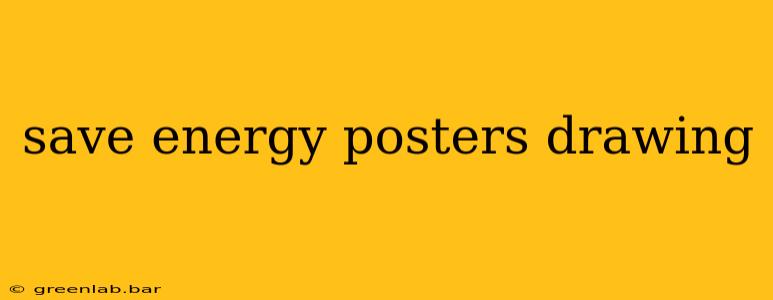Saving energy is crucial for our planet's future, and visual communication can be a powerful tool to promote energy conservation. Posters, with their eye-catching designs and concise messaging, are ideal for raising awareness and inspiring action. This guide offers creative drawing ideas for energy-saving posters, targeting different audiences and incorporating effective design elements.
Targeting Different Audiences:
The effectiveness of your poster depends greatly on who you're trying to reach. Consider tailoring your design and message accordingly.
Kids and Young Adults:
- Cartoon Characters: Use playful characters engaging in energy-saving activities like turning off lights or recycling. Think bright colors, simple shapes, and a fun, approachable style.
- Interactive Elements: Incorporate puzzles, mazes, or hidden objects related to energy saving to make the poster more engaging.
- Mascots: Design a memorable mascot, like a friendly energy-saving superhero or animal, to represent the campaign.
Adults and Families:
- Data Visualization: Use charts and graphs to show the impact of energy conservation – reduced carbon footprint, money saved, etc. Keep it clean and easy to understand.
- Real-Life Scenarios: Depict everyday situations where energy is wasted and offer simple solutions. For example, show a family leaving lights on, and then show them turning them off.
- Before & After: Illustrate the positive changes that occur when energy is saved – a greener environment, a more comfortable home, etc.
Businesses and Organizations:
- Professional Design: Use a sophisticated and clean aesthetic, emphasizing professionalism and credibility.
- Statistics and Facts: Highlight data on energy consumption and the cost savings of efficient practices.
- Call to Action: Clearly state what the organization wants viewers to do – visit a website, implement a program, etc.
Effective Design Elements:
Regardless of your target audience, certain design elements are crucial for creating an impactful poster:
Color Palette:
- Green: The universally recognized color for environmentalism.
- Blue: Represents water conservation, often linked to energy efficiency.
- Yellow/Orange: Can be used to highlight key messages or calls to action.
Imagery:
- Simple and Clear: Avoid overly complex or cluttered imagery. The message should be instantly understandable.
- Symbolic Representation: Use symbols to represent energy sources (sun, wind, water) or energy efficiency (lightbulb, plug).
- High-Quality Images: Use crisp, professional-looking images to maintain credibility.
Typography:
- Easy-to-Read Fonts: Choose fonts that are legible and visually appealing.
- Hierarchy: Use different font sizes and styles to create a visual hierarchy, emphasizing key information.
- Concise Messaging: Keep text to a minimum, focusing on impactful keywords and calls to action.
Call to Action:
- Clear and Concise: Tell the viewer exactly what you want them to do.
- Action-Oriented Language: Use verbs that encourage action (e.g., "Save," "Reduce," "Conserve").
- Contact Information: Include website addresses, social media handles, or phone numbers for further information.
Creative Drawing Techniques:
Experiment with different drawing styles to find what best suits your message and target audience. Consider:
- Digital Illustration: Offers precision and ease of editing.
- Hand-Drawn Illustrations: Adds a personal touch and can create a unique aesthetic.
- Collage: Combines different images and textures for a visually striking effect.
- Mixed Media: Combine different techniques (e.g., drawing and painting) for added depth and texture.
By combining thoughtful design choices with compelling imagery and messaging, your energy-saving posters can effectively communicate the importance of energy conservation and inspire positive change. Remember to tailor your approach to your specific audience for maximum impact.

